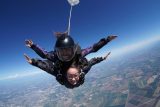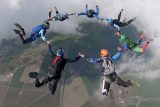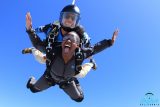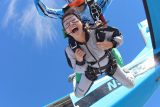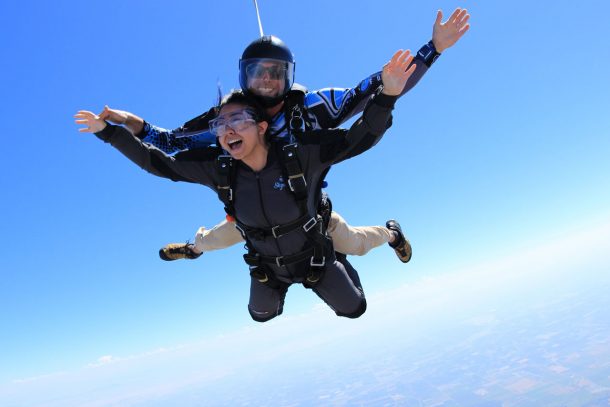Lights, Camera, Action! The clapperboard snaps shut and the filming begins. But how much of what will appear on screen is even remotely close to “real life?” As the regent of embellishment, Hollywood takes creative license with just about every subject–and that includes skydiving.
In one way or another, most action films require the audience to distance themselves from the confines of logic through a willing suspension of disbelief. Just how likely is it that every hero could stroll away from a massive explosion without dislodging a hair on his or her perfectly coiffed hair, barely batting an eye at the thunderous roar of the blast? Though we’re no explosion experts, we’re going to wager it’s not very likely.
Most discerning viewers know what they are seeing isn’t spot on to what the real experience would be like, but for the sake of enjoying a film, they accept it. However, for the typical observer of a death-defying skydiving scene, it can be hard to know where the real thing ends and the Hollywood glamour begins.
This is where your friends at Skydive California come in. As your resident skydiving experts, we figured we’d set the record straight, answer a few questions, and show you some of the differences between skydiving movies vs real life.
How Do People Film A Skydiving Scene?
If a skydiving scene is going to be as authentic as possible, it needs to be filmed in the air.
For in-air video, Hollywood calls upon the skills of professional skydiving videographers. These videographers utilize a series of cameras mounted to their helmets. Naturally, to maintain a stable body position while freefalling at terminal velocity and filming another person free falling at terminal velocity, all while keeping the subject in the frame, requires some remarkable skydiving talent to accomplish. Take for example the incredible camera flying produced by Craig O’Brien for the Mission Impossible: Fallout HALO Jump stunt.
It’s important to know you cannot simply strap a camera to your noggin, leap from a plane, and expect anything good to come from it. Becoming a camera flyer at all requires a significant amount of flying skill and skydiving expertise.
Point Break Skydive: Freefall Doesn’t Last Forever
Point Break is a skydiving cult classic and features two separate skydiving scenes involving Patrick Swayze and Keanu Reeves. In one tense scene, after reaching 4,000 feet, Patrick Swayze leaps from the aircraft. After a slight delay, Keanu Reeves, desperate to catch Swayze, follows after–sans parachute.
The skydiving scene lasts about 90 seconds before the parachute is finally deployed. Considering the terminal velocity of a body in freefall, one falls about 3,000 feet in 20 seconds. The math here simply doesn’t add up!
Luckily, on a skydive with Skydive California, you’ll be ascending to 13,000 feet before exiting the aircraft giving you anywhere from 45 to 60 seconds of adrenaline-packed freefall. As for jumping without a parachute? No way! You’ll be securely attached via a harness to a skydiving instructor and parachute container.
If you want to see a real-life leap without a parachute, check out Heaven Sent: a special covering Luke Aikens’ jump from 25,000 feet into a net without a parachute.
Bucket List Skydive: You Won’t See Another Tandem Pair In Freefall
The skydiving scene in the comedy-drama the Bucket List, starring Jack Nicholson and Morgan Freeman takes a bit of artistic license when it comes to an actual tandem skydive.
In the Hollywood scene, Jack Nicholson and Morgan Freeman are on tandem skydives with only a few feet between them. In real life, tandem skydivers are separated by hundreds of feet of horizontal separation to ensure that parachutes are not opening near each other.
Furthermore, even if you had quite a set of lungs, between the speeds you are reaching and the whooshing sound of freefall, you wouldn’t be able to hold a conversation on a skydive. This is why, in real life, skydivers use certain hand signals to communicate with each other.
Fandango Skydiving Scene: Learning To Skydive Takes Time
To prepare for your first solo jump will take a bit longer than this classic scene would have you believe.
For starters, the type of skydiving this movie refers to is called static line. Though once a popular method for learning to skydive (and still used for military skydiving operations today) modern civilian skydiving centers use a form of skydiving progression called Accelerated Freefall. In this progression, a typical first jump skydiving course, like the one offered at Skydive California, is an intensive, hands-on ground school that lasts anywhere from 4-6 hours. Following the successful completion of this course, an individual will make their first solo skydive. Although, even then, s/he isn’t going it all alone and is accompanied by two certified instructors.
If you’d like the experience of skydiving without intensive ground training, a tandem skydive is a perfect fit. Because you are physically attached to a licensed skydiving instructor on a tandem skydive, your training session is only 20 minutes long.
Even though skydiving scenes are often embellished, watching skydiving on the screen is nothing compared to the real thing! Put Hollywood to the test and schedule your first skydive with Skydive California today!
